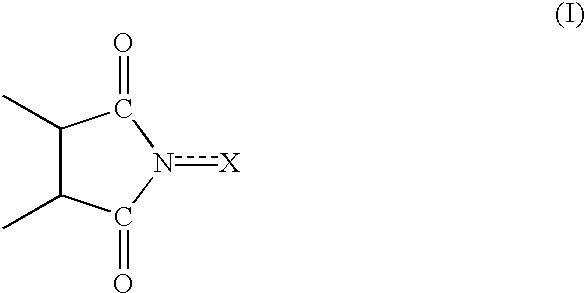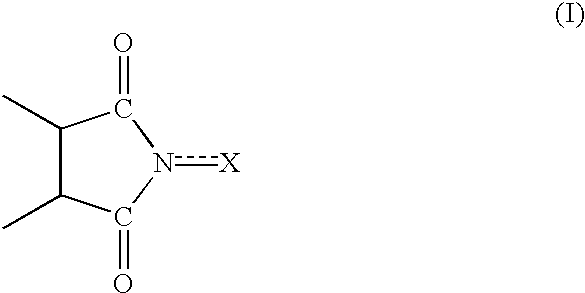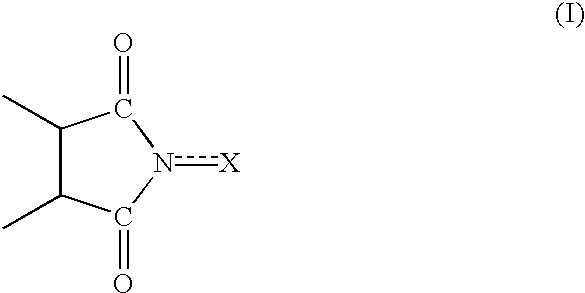Process for preparing cycloalkanone
a technology of cycloalkanone and process, applied in the field of cycloalkanone, can solve the problems of low production rate of cyclohexanone, process requires the use of expensive exhaust gas treatment facilities, and the inability to obtain cyclohexanone with high efficiency
- Summary
- Abstract
- Description
- Claims
- Application Information
AI Technical Summary
Benefits of technology
Problems solved by technology
Method used
Image
Examples
example 1
(1) Catalytic Solution-preparing Step
A catalytic solution was prepared in proportions of cyclohexane 10,000 g / H, N-hydroxyphthalimide 10 g / H, and cotaltacetonato 64 g / H.
(2) Oxidation Step
The catalytic solution prepared in the above proportion, cyclohexane, and air were fed to a reactor 2 at rates of supply of 840 g / H and 1.3 Nm.sup.3 / H, respectively, and the mixture was reacted at 160.degree. C. and 40 atm for a residence time of two hours. At a conversion of 11%, the cyclohexane was converted into a cyclohexanone and a cyclohexanol at selectivities of 40% and 49%, respectively.
(3) Catalyst-separating Step
The crude reaction mixture was cooled to 20.degree. C., and the catalyst was separated by filtration at a rate of 9.8 g / H. The separated catalyst was treated by incineration to recover the cobalt contained therein and then recycled to the reaction system for reuse. In an extraction column 4 equipped with rings and plates, the filtrate was subjected to an extraction step with water...
example 2
(1) Catalysti Solution-preparing Step
A catalytic solution was prepared in proportions of cyclohexanone 1,000 g / H, N-hydroxyphthalimide 160 g / H, and cobalt acetonato 64 g / H.
(2) Oxidation Step
The catalytic solution prepared in the above proportion, cyclohexane, and air were fed to a reactor 22 at rates of supply of 840 g / H and 1.3 Nm.sup.3 / H, respectively, and the mixture was reacted at 160.degree. C. and 40 atm for a residence time of four hours. At a conversion of 32%, cyclohexane was converted into a cyclohexanone and a cyclohexanol at selectivities of 89% and 5%, respectively.
(3) Catalyst-separating Step
The crude reaction mixture was cooled to 20.degree. C., and the catalyst was separated by filtration at a rate of 158 g / H. In an extraction column 24 equipped with rings & plates, the filtrate was subjected to an extraction step with water at 20.degree. C. to extract an acid having a higher-boiling point and the like.
(4) Lower-boiling Point Component-separating Step
In a perforated...
example 3
(1) Catalytic Solution-preparing Step
A catalytic solution was prepared in proportions of acetic acid 1,000 g / H. N-hydroxyphthalimide 160 g / H, and cotalt acetonato 64 g / H.
(2) Oxidation Step
The catalytic solution prepared in the above proportion, cyclohexane, and air were fed to a reactor 32 at rates of supply of 840 g / H and 1.3 Nm.sup.3 / H, respectively, and the mixture was reacted at 75.degree. C. and 40 atm for a residence time of 4 hours. At a conversion of 31%, the cyclohexane was converted into a cyclohexanone and a cyclohexanol at selectivities of 90% and 5%, respectively.
(3) Lower-boiling Point Component Separating Step
In a forced circulation-type evaporator, the crude reaction mixture was separated into the lower-boiling point component comprised of cyclohexane, water and others, and the higher-boiling point component comprised of acetic acid, the KA oil, the catalyst and others. Using a perforated-plate column with 30 plates, water and the cyclohexane were separated from the...
PUM
| Property | Measurement | Unit |
|---|---|---|
| Substance count | aaaaa | aaaaa |
| Substance count | aaaaa | aaaaa |
| Substance count | aaaaa | aaaaa |
Abstract
Description
Claims
Application Information
 Login to View More
Login to View More - R&D
- Intellectual Property
- Life Sciences
- Materials
- Tech Scout
- Unparalleled Data Quality
- Higher Quality Content
- 60% Fewer Hallucinations
Browse by: Latest US Patents, China's latest patents, Technical Efficacy Thesaurus, Application Domain, Technology Topic, Popular Technical Reports.
© 2025 PatSnap. All rights reserved.Legal|Privacy policy|Modern Slavery Act Transparency Statement|Sitemap|About US| Contact US: help@patsnap.com



